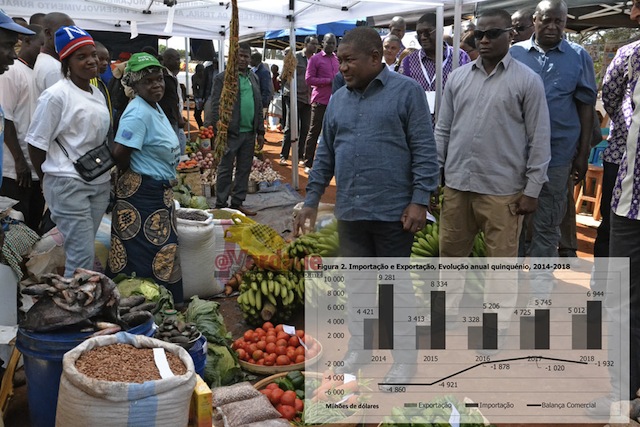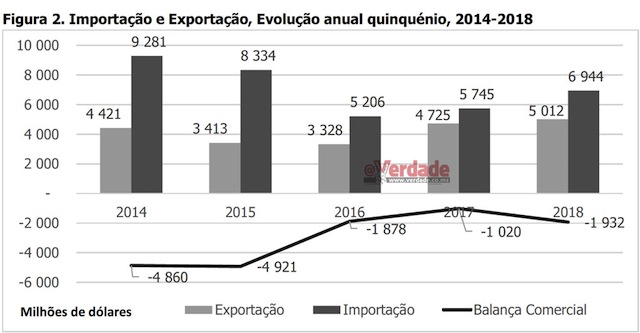Mozambique's private sector records strongest increase in activity for two years -PMI
Mozambique continues to import… giblets, eggs, potatoes, vegetables, rice, tea an even corn

Picture: A Verdade
Mozambique’s foreign trade statistics show that, over the past year, agricultural imports have grown by 26.6 per cent, notably in the offshore purchase of giblets, eggs, potatoes, vegetables, rice, tea and even corn.
Compounding the situation, the National Statistics Institute (INE) warns of a “high dependence and little diversification of exports”, which continue to be dominated by coal and aluminium.
Foreign trade statistics for 2018 analysed by @Verdade counter all the rhetoric concerning the supposed diversification of the Mozambican economy. The main groups of exported goods were mineral fuels (including coking coal belongs) worth US$2.3 billion and representing 46 percent of all exports, and common metals (including aluminium) at US$1.4 billion, representing 26.9 percent.
“This product group totals 72.9 percent of exported goods, which indicates high dependence and little diversification of exports,” the INE says in a document released this week.
““With regard to traditional product groups, which have become less and less representative in recent years in view of the emergence of mineral resources of high export value, the food group stands out with US$208.5 million corresponding to 4.2 per cent (in face of a 154.8 per cent growth) and agricultural products with 4.1 per cent (a decrease of 6.4 per cent),” the 2018 statistics analysed by @Verdade reveal.
The INE highlights that, of the 130 countries which imported goods from Mozambique, the main destination was India (27.3 percent), followed by South Africa (17.4 percent), the Netherlands (12.2 percent), China (4.8 per cent) and Singapore (4.6 per cent).
As far as imports are concerned, @Verdade has ascertained that the main groups were mineral fuels, with an amount of US$1.6 billion and corresponding to 23.1 percent, machinery and appliances with US$1.3 billion, and agricultural products with US$ 872.6 million. Imports of agricultural products grew 26.6 percent compared to the US$688.9 million imported in 2017.

Balance of trade deficit of US$1.93 billion in 2018
Of concern is the list of products whose imports should be falling, judging by the claims of increasing national food production.
@Verdade found out that last year US$13.4 million was spent on imports of poultry meat and giblets, compared to US$8.9 in 2017. Egg imports were worth US$9.6 million, compared to US$6 million the previous year. Potato imports were US$19.5 million in 2018, almost double 2017’s US$10.7 million. We imported US$20.5 million in vegetables, up from US$11.1 a year earlier. Even tea and maize continue to be imported and in 2018 Mozambique spent US$4.3 million and US$41.5 million on these products respectively.
@Verdade has learned that South Africa remains Mozambique’s main supplier (27.8 percent), followed by China (11.5 percent), the United Arab Emirates (7.5 percent), the Netherlands (7.5 per cent) and India (7.1 per cent).
In 2018, foreign goods totalling US$11.95 billion were traded, against US$10.47 billion in 2017, “but this figure still remained below the high levels achieved in 2013 (US$14.12 billion) and 2014 (US$13.47 billion),” the INE declares.

The trade statistics also show that the trade balance in 2018 deteriorated by US$911.7 million to a deficit of US$1.93 billion in 2018, up from the US$1.02 billion in 2017 (its most favourable ever).
This trade deficit weighed on the Bank of Mozambique’s balance of payments, which in 2018 registered a deficit of US$4.3 billion against the previous year’s current account deficit of US$2.6 billion.
By Adérito Caldeira












Leave a Reply
Be the First to Comment!
You must be logged in to post a comment.
You must be logged in to post a comment.